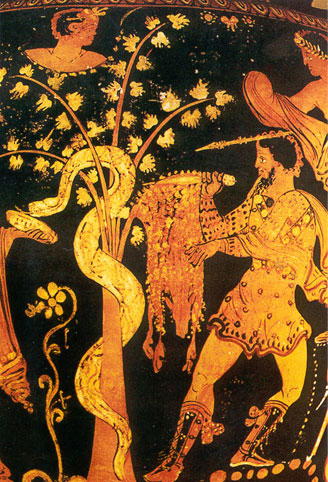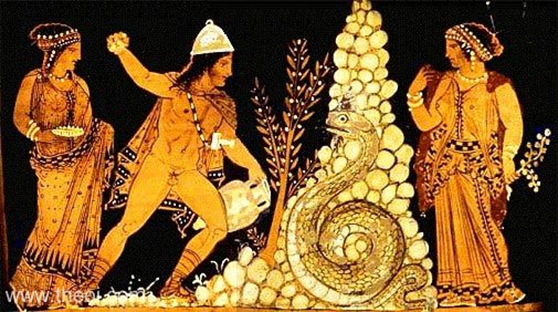Serpent | Snake | Dragon
In Greek Mythology
In one way or another, three different categories of serpents are linked to the evolution willed by the Divine, whether they oppose it, promote it, or prevent it until the time comes. In the latter case, occult traditions call them ‘guardians of the threshold’; that is to say, a step cannot be taken unless certain conditions are met.
In Greek mythology, it is rather difficult to distinguish between snakes, serpents, and dragons because of the long periods of time that lapsed between various authors and the gradual disappearance of their original symbolism.
However, two main categories can be distinguished:
Snakes
Snakes, depending on the context, represent negative or more rarely positive energies.
In the category of negative energies are, for example, the snakes that adorn the head of the Gorgon, symbolising the negative energies generated by fear, or the heads of the Lernaean Hydra, which symbolise numerous desires. These heads grow back when cut off – the symbolic representation of the desires that keep coming back, unless they are purified by inner fire.
In the category of positive energies are, for example, the snakes that purify the ears of the soothsayers, such as Cassandra whose ears were licked by two snakes.
Dragons
Dragons are giant snakes, i.e. extremely powerful energies. They have no wings and do not spew fire.
Generally speaking, they are ‘guardians of the threshold’. Their name – δράκων / drákōn – comes from the verb δέρκομαι/dérkomai which means ’to see, to pierce with the eye’, that is, the spiritual force represented by the dragon can ‘see’ the seeker in his innermost truth and decide whether he is ready to face the initiatory test that marks the passage. Note that the term ‘drakon’ in Ancient Greek texts refers to both the large snake and the guardian.
The best-known dragons are:
- The Colchian dragon guarding the Golden Fleece of the Jason and the Argonauts’ myth:
Jason and the Golden Fleece Naples National Archaeological Museum. Wikimedia Commons. Public domain
- The Dragon guarding the spring of Ares in Thebes:
Cadmus and the Dragon Louvre Museum. Public domain
The teeth of the latter dragon, which represent the evolutionary knots still present in the being, will be sown half by Cadmus and half by Jason, and from the earth will emerge fierce warriors threatening to destroy the hero.
- The dragon who guards the Golden Apples in the Garden of the Hesperides is the protector of true Knowledge.
All these dragons are actually beneficial because they protect the seeker.
In the category of dragons, however, fall female dragons who represent the perverted energies of evolution. For instance, Echidna, the monstrous she-dragon (drakaina) with the head and breast of a woman and the coiled tail of a serpent. She is the symbol of perverted evolution, ‘the stopping of evolution in union’. (See It was the hour before the Gods awake.)
In Savitri
Sri Aurobindo seems to have clearly distinguished quite clearly the following three categories:
Serpent
15 mentions
It generally symbolises the positive or divine energies such as Kundalini:
— Book 7 Canto 5
or a guardian:
— Book 2 Canto 3
Snake
Six mentions.
In Savitri, it is always the force of darkness opposing the divine evolutionary plan. For example:
And faced the enchantments of the demon Sign,
And traversed the ambush of the opponent Snake.
— Book 2 Canto 8
Or again:
On her black tripod of the triune Snake
Reading by opposite signs the eternal script,
A sorceress reversing life’s God-frame.
— Book 2 Canto 8
Dragon
11 mentions
Unalterable the law of Chance and Death;
— Book 3 Canto 4
Still a great dragon body sullenly loomed;
Adversary of the slow struggling Dawn
Defending its ground of tortured mystery,
It trailed its coils through the dead martyred air
And curving fled down a grey slope of Time.
— Book 10 Canto 1
Dragon always refers to the dark power of the unconscious, with one exception:
— Book 1 Canto 2

